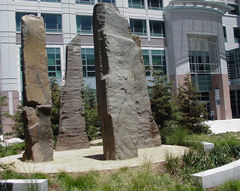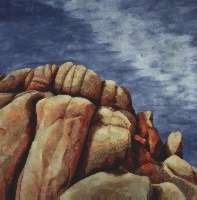Artwork was incorporated into this project per a City ordinance that requires a certain percentage of construction costs of capital improvement projects be allocated for public arts. The art program is administered and coordinated through the City of Sacramento’s Art in Public Places (APP) Committee, and the Sacramento Metropolitan Arts Commission. Artwork from four prominent artists is displayed at the building.
The artists for this project were selected through limited and open competition methods. The artists were requested to submit their qualifications, proposals and maquettes (models) if applicable, and the submittals were reviewed by selection panels consisting of members of the project team, arts professionals, and community members, in meetings open to the public. For more information on the City’s Art in Public Places program please call 264-5558. The art pieces include:
Courtyard Sculpture: Beverly Pepper
As you approach the building, the first artwork you will encounter is a stone sculpture set back into and against the grove of sequoia trees. Beverly Pepper, an internationally respected artist, designed the imposing stone sculpture. The courtyard is an area where tenants and visitors of the building can relax and enjoy California’s beautiful outdoors. The grove of sequoia trees that provides shade and beauty. Within the trees are benches and rock outcroppings for seating.
It is Ms. Pepper’s belief “that the protection and stewardship responsibilities of the EPA are sacred responsibilities. What is more important than ensuring for our children and children’s children a world of natural beauty and diversity, clean air and water, and a world that can be lived in with pleasure and trust? The monolithic sculpture and configuration of the sculpture would invoke the figure of the sentinel as a monument to the sacred duty of protecting nature.”
Ms. Pepper’s daughter, Pulitzer Prize winning poet Jorie Graham, provided the text and images of the sculptures. Ms. Pepper’s work can be found throughout the world from New York City to Barcelona to Zurich to the Smithsonian Institution.
The courtyard also serves as home to stone that was long ago cut to be used elsewhere. In 1880 California quarries gave up many tons of brownstone to be used in building the San Francisco Ferry Building. During the course of that construction, some of the stone, already having been excavated, was rejected by the architects, and left in a field to age. One hundred twenty years later, as he was surveying California quarries for local stone to be used in the plaza, CalEPA’s architect, David Martin, discovered this stone resting place.
Lobby Sculpture: Richard Hunt
In the lobby, the staircase to the second floor is a stainless steel sculpture. The artist, Richard Hunt, creates abstract metal works, each a unique shrine to the human spirit. Richard Hunt has completed almost 100 public sculptures large and small. The sculpture, which is being developed specifically for the CalEPA building, is tentatively titled, “Man’s Way, Nature’s Way.” The theme, according to Mr. Hunt, “is some of the ways man and nature originate and modify form. The sculpture, in its complex spatial organization of internal, external, natural and architectonic relationships, seeks to represent sculpturally ideas of building a base, frame and reference for human interaction with the environment.”
Mr. Hunt, a graduate of The School of the Art Institute of Chicago, has been a professor or artist in residence at several prestigious universities. His work is displayed in a number of public buildings, as well as at the Hirschhorn Museum and Sculpture Garden, National Gallery, The Metropolitan Museum of Art, and The Los Angeles County Museum of Art, to name a few.
Glass Chandelier: Dale Chihuly
Two chandeliers, designed by world-renowned artist, Dale Chihuly, are hung from the ceiling on the I Street side of the second floor prefunction area. The chandeliers are composed of hundreds of pieces of blown glass in organic-like forms in the selected colors of yellows and greens playing on the environmental theme of our agency’s mission.
Dale Chihuly was introduced to glass when studying interior design at the University of Washington. In 1971, Chihuly cofounded Pilchuck Glass School, 50 miles north of Seattle. Now considered “an international glass communications center,” it attracts students and teachers from around the world. Chihuly has been the recipient of many awards including honorary doctorates. He is a Fellow of the American Craft Council and has received the Governor’s Art Awards from both Rhode Island and Washington. He has also been honored with two fellowships from the National Endowment for the Arts, the American Council for the Arts Visual Artist’s Award, and the Louis Comfort Tiffany Foundation Award. In 1992 he was named the first National Living Treasure in the United States.
His work is included in more than 170 museum collections from New York to Kyoto. To learn more about Chihuly’s works, visit his Web site at http://www.chihuly.com.
Art Quilts: Merle Serlin
Merle Serlin created eight art quilts housed throughout the building. Merle is an architect by trade and training, and her pieces are very architectural in nature. The art element of this project is the most human scale and its form and fabric texture the most human–providing contrast to the other art pieces that are large scale, and are in stone, brushed aluminum, or glass.
Each quilt is a representation of one of California’s special and environmentally sensitive geographic features. The subject of the quilts and the floor on which they are displayed follows:
- Mount Shasta (25th floor)
- Lake Tahoe (21st floor)
- Joshua Tree (19th floor)
- Central Coast Foothills (17th floor)
- Headwater Redwoods (12th floor)
- Delta (8th floor)
- Central Coast (5th floor)
- Monterey Bay Canyon (3rd floor)
The artist notes “Each of the sites is remarkable for its beauty, its fragility and its need for protection. This reflects the CalEPA mission statement to improve environmental quality in order to protect public health, the welfare of our citizens, and California’s natural resources.” Ms. Serlin uses various fabrics, textures, finishes and embroidery to create her quilts. Capitalizing on these elements, she is able to create dimension in the quilts.

